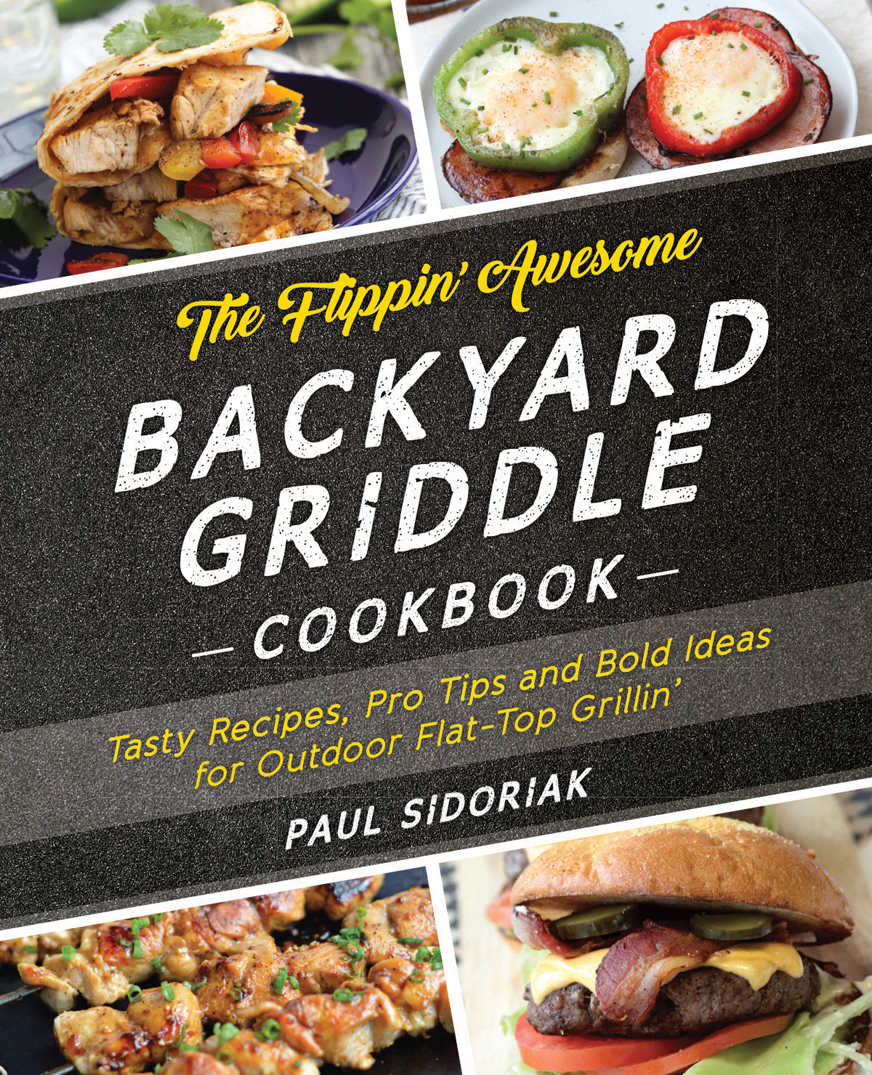
Table of Contents
Guide
Text and photographs copyright 2018 Paul Sidoriak except as noted below. Design and concept copyright 2018 Ulysses Press and its licensors. All rights reserved. Any unauthorized duplication in whole or in part or dissemination of this edition by any means (including but not limited to photocopying, electronic devices, digital versions, and the internet) will be prosecuted to the fullest extent of the law.
Published by
Ulysses Press
P.O. Box 3440
Berkeley, CA 94703
www.ulyssespress.com
ISBN: 978-1-61243-821-4
Acquisitions editor: Casie Vogel
Managing editor: Claire Chun
Editor: Lauren Harrison
Proofreader: Shayna Keyles
Front cover design: Malea Clark-Nicholson
Cover images: food @DashofSavory except chicken yakitori Paul Sidoriak; gray background jirakit suparatanameta/shutterstock.com
Interior design/layout: what!design @ whatweb.com
Interior recipe images: Paul Sidoriak; selected shots @DashofSavory (see page 113 for a list of recipes)
Other images from shutterstock.com: gray background jirakit suparatanameta; food press Dani Simmonds; analog probe thermometer Joy iStyleon; leave-in digital probe thermometer byggarn.se; ginger/garlic JIANG HONGYAN; lemons AlenKadr
Distributed by Publishers Group West
IMPORTANT NOTE TO READERS: This book is independently authored and published and no sponsorship or endorsement of this book by, and no affiliation with, any trademarked brands of the griddle grill or other trademarked brands or products mentioned within is claimed or suggested. All trademarks that appear in this book belong to their respective owners and are used here for informational purposes only. The author and publisher encourage readers to patronize the quality brands and products mentioned in this book. Take special note of the important safety warnings throughout this book, and always use customary precautions for safe food preparation, handling, and storage.
To Chery
Thank you for supporting my successes and failures, both on and off the grill.
Table of Contents
The griddle grill has long been an indispensable fixture in diners and restaurantsthe sizzling-hot top gives a great char to meat and anything you cook on it. But the old metal flat-top grills found in restaurants were big, heavy, and expensive, making them unappealing and impractical to the home cook, not to mention unsightly. Even the most gourmet home kitchens passed on a griddle grill in favor of other high-end domestic appliances.
Now, manufacturers make griddle grills that are more affordable, lighter, and more attractive. But what I most attribute to their significant spike in popularity is the adaptation of the fuel source: Todays griddle grills are designed to burn bottled propane. They no longer require a connection to a fixed natural gas line that necessitates ventilation in a home kitchen. With bottled propane, the fuel source is portable, transforming the hulking, stationary grills into perfect outdoor cooking devices.
The first time I cooked on one of the recently manufactured outdoor griddle grills, it took me back more than 25 years to cooking as a high school kid in the snack bar and restaurant at the golf course where I worked. Nostalgic aromas wafted over me as I christened my griddle with its first pound of bacon, and I instantly remembered how fun it is to cook on the griddle grill. That night, we had smash-style bacon burgers on butter-crisped buns just like you get at the best old-fashioned burger joints. Because, guess what, youre using the same style of equipment the professionals are.

Cooking on a flat-top griddle grill is fun. This book will show you a bunch of the tips, techniques, and equipment the professionals use so you can easily re-create restaurant-quality experiences in your own backyard. I challenge you to think beyond pancakes, bacon, and hash browns, and consider cooking things like chicken Parmesan, scallops with asparagus tips, and crunchy ramen noodle and veggie stir-fries.
I will also talk about two-zone cooking, temperature control, and maintaining your flat-top griddle grill, and give you 50 fun and delicious recipes so you can be cooking like a pro in no time.
Cooking on a griddle grill dates back to the Aztecs, who prepared corn tortillas and other foods on a flat surface made of clay, called the comal. The ancient griddle surfaces worked well for the some of the same reasons we still cook on them today: They maintain heat well, theres plenty of available cooking surface, and you simply place the surface over a fire or a bed of hot coals to operate. As time and technology advanced, Central Americans and Mexicans began constructing metal cooking surfaces called planchas, or metal plates.
And if you have ever been to a teppanyaki-style restaurant like Benihana, the griddle, or teppan, becomes a part of the experience and entertainment as you are seated at the griddle and have the opportunity to watch your food be cooked right in front of you.
Whether you are cooking on a plancha, comal, griddle, teppan, or hot plate, the principles are basically all the same. The cooking surface is sturdy, heavy, mostly flat, absorbs and retains heat well, and often develops a smoother, or seasoned, cooking surface the more frequently it is used. If you imagine what a native indigenous village would have been like at dinner time, there were most likely lots of mouths to feed. Griddle grills allow a lot of food to be prepared simultaneously so people could be fed at or around the same time.
Today, the griddle grill is an indispensable time-saving asset to any commercial kitchen. If you think about what a family of four may order at the local breakfast spot, cooking on the griddle grill is much faster than using individual pots and pans for each item. A short stack of pancakes, two eggs, bacon, home-fried potatoes, French toast, sausages, and a Denver omelet would take 11 pans and burners to make a breakfast for four. But with the griddle, it is one continually running cooking surface that takes far less time to clean between orders, making it much more popular than a pan and burner.
Flat-top griddle grills differ from regular grills because the griddle itself prevents the food from coming into direct contact with the flame. There are two significant benefits to this. One, the food can be juicier because it is not dried out by direct exposure to the heat source. The other benefit is that a griddle grill uses the principle of conduction, which transfers heat via the hot surfaces direct contact with the food. Not only is this an efficient cooking method, but it promotes browning, also known as the Maillard reaction, which adds additional flavor and makes your food more visually appealing. One of the benefits of cooking on the griddle is that you increase the surface area on which the Maillard reaction can occur, essentially browning more of the meat.
There are a couple of griddle grill manufacturers that make the majority of backyard griddle grills seen on patios today. Both can be found in discount stores, box stores, sporting goods stores, hardware stores, and most places a gas grill can be purchased. As the popularity of the griddle grill continues to grow, there are bound to be other quality manufacturers in the marketplace.







